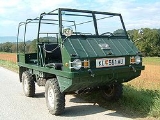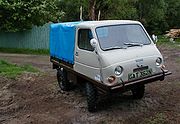
Haflinger
Encyclopedia

Four Wheel Drive
The Four Wheel Drive Auto Company, more often known as Four Wheel Drive or just FWD, was founded in 1909 in Clintonville, Wisconsin, as the Badger Four-Wheel Drive Auto Company by Otto Zachow and William Besserdich.-History:...
, high mobility vehicle about 3.5 m long and 1.5 m wide, powered by a 643 cc twin horizontally opposed, rear mounted, air-cooled engine
Air-cooled engine
Air-cooled engines rely on the circulation of air directly over hot parts of the engine to cool them.-Introduction:Most modern internal combustion engines are cooled by a closed circuit carrying liquid coolant through channels in the engine block and cylinder head, where the coolant absorbs heat,...
. Weighing around 600 kg (1322.8 lb), the Haflinger can be lifted by four strong people and yet can carry a load of 500 kg (1102.3 lb). This truck falls into the category of the light utility vehicle
Light Utility Vehicle
Light utility vehicle is a general term for small, jeep-like military trucks for tactical use. They are generally short, relatively light compared to other trucks and cars, unarmored with 4-wheel drive and short body overhangs for all-terrain mobility and at least 4 passenger capacity...
.



Willys MB
The Willys MB US Army Jeep and the Ford GPW, were manufactured from 1941 to 1945. These small four-wheel drive utility vehicles are considered the iconic World War II Jeep, and inspired many similar light utility vehicles. Over the years, the World War II Jeep later evolved into the "CJ" civilian...
and Ford GPW Jeep
Jeep
Jeep is an automobile marque of Chrysler . The first Willys Jeeps were produced in 1941 with the first civilian models in 1945, making it the oldest off-road vehicle and sport utility vehicle brand. It inspired a number of other light utility vehicles, such as the Land Rover which is the second...
. A decade after hostilities ended, the Austrian Army was considering the retirement of the aging Jeeps in favor of something more contemporary as well as locally designed and produced. The design genius of Erich Ledwinka was utilized by the Austrian firm Steyr-Daimler-Puch
Steyr-Daimler-Puch
Steyr-Daimler-Puch was a large manufacturing conglomerate based in Steyr, Austria, which was broken up in stages between 1987 and 2001. The component parts and operations continued to exist under separate ownership and new names.-History:...
to produce and field test prototypes. Once the production model design was finalized, the trucks were manufactured between 1959 and 1975 and were exported all over the world. The manufacturer designated the trucks as "Type Multipurpose Passenger Vehicle". A total of 16,647 were made with approxiomately 7,000 of them being recruited into military service by the Swiss
Switzerland
Switzerland name of one of the Swiss cantons. ; ; ; or ), in its full name the Swiss Confederation , is a federal republic consisting of 26 cantons, with Bern as the seat of the federal authorities. The country is situated in Western Europe,Or Central Europe depending on the definition....
, Austria
Austria
Austria , officially the Republic of Austria , is a landlocked country of roughly 8.4 million people in Central Europe. It is bordered by the Czech Republic and Germany to the north, Slovakia and Hungary to the east, Slovenia and Italy to the south, and Switzerland and Liechtenstein to the...
n and Australia
Australia
Australia , officially the Commonwealth of Australia, is a country in the Southern Hemisphere comprising the mainland of the Australian continent, the island of Tasmania, and numerous smaller islands in the Indian and Pacific Oceans. It is the world's sixth-largest country by total area...
n armies and the Royal Navy. Some of the Australian Army trucks saw service in Viet Nam during that conflict. The majority of the Haflinger trucks entered directly into the hands of private owners around the world with a small number also being placed into municipal, ambulance and fire brigade services. Just like its predecessor, the US Army Jeep, the Haflinger trucks are at home both off and on road. They have been licensed for on-road use throughout Europe, North and South America, Asia, Africa and Australia. During their 16 year production run, the trucks not only saw domestic sales in Austria but were exported to thirty-five other countries. The first trucks to see use in the United States arrived in 1960. In 1983, a gentleman drove his newly purchased used Haflinger from Vermont back to his home in California. While that is an impressive journey, it pales in comparison to the journey documented by famous Austrian travel journalist Ernst Wiese in his book 10,000 Miles Through Arabia. That work describes his four month long travels from Vienna to the southern tip of the Arabian peninsula and back in his "brave Haflinger". Due to its multi-functional capabilities, many in Europe refer to these vehicles as cars, trucks as well as the "Austrian Jeep". Since August, 2006 there exists a web-project that wants to document the different Haflinger types, the many details and the changes that came with the years of production. See: Haflinger TDC
Particular features that add to the off-road capability include:
- Exceptionally low center of gravity due to the low placement of the chassis and the lack of upper bodywork
- Generous approach and departure angles
- The provision of both front and rear differential locks enables the vehicle to make progress even if only one wheel is in firm contact with the ground.
- The 'portal' type design of the front and rear axles means that the centre of the axle is above the centre of the wheel, thus increasing ground clearance under the axle without the need to increase the wheel diameter. Power is transmitted from the axle to the wheel via drop gears in each wheel hub.
- The suspensionSuspension (vehicle)Suspension is the term given to the system of springs, shock absorbers and linkages that connects a vehicle to its wheels. Suspension systems serve a dual purpose — contributing to the car's roadholding/handling and braking for good active safety and driving pleasure, and keeping vehicle occupants...
is fully independentIndependent suspensionIndependent suspension is a broad term for any automobile suspension system that allows each wheel on the same axle to move vertically independently of each other. This is contrasted with a beam axle, live axle or deDion axle system in which the wheels are linked – movement on one side affects...
, each half-axle having about 25 cm of free movement.
Most enthusiasts are found in Germany
Germany
Germany , officially the Federal Republic of Germany , is a federal parliamentary republic in Europe. The country consists of 16 states while the capital and largest city is Berlin. Germany covers an area of 357,021 km2 and has a largely temperate seasonal climate...
and Austria
Austria
Austria , officially the Republic of Austria , is a landlocked country of roughly 8.4 million people in Central Europe. It is bordered by the Czech Republic and Germany to the north, Slovakia and Hungary to the east, Slovenia and Italy to the south, and Switzerland and Liechtenstein to the...
, where there are thriving clubs. There are also many owners/enthusiasts in the UK
United Kingdom
The United Kingdom of Great Britain and Northern IrelandIn the United Kingdom and Dependencies, other languages have been officially recognised as legitimate autochthonous languages under the European Charter for Regional or Minority Languages...
, USA
United States
The United States of America is a federal constitutional republic comprising fifty states and a federal district...
, Canada
Canada
Canada is a North American country consisting of ten provinces and three territories. Located in the northern part of the continent, it extends from the Atlantic Ocean in the east to the Pacific Ocean in the west, and northward into the Arctic Ocean...
, Australia
Australia
Australia , officially the Commonwealth of Australia, is a country in the Southern Hemisphere comprising the mainland of the Australian continent, the island of Tasmania, and numerous smaller islands in the Indian and Pacific Oceans. It is the world's sixth-largest country by total area...
, and Asia
Asia
Asia is the world's largest and most populous continent, located primarily in the eastern and northern hemispheres. It covers 8.7% of the Earth's total surface area and with approximately 3.879 billion people, it hosts 60% of the world's current human population...
. One of the more important club meetings is held every year at the village of Hafling (Avelengo)
Hafling
Hafling is an Italian comune .Hafling is located in South Tyrol in the Italian region Trentino-Alto Adige/Südtirol, about 70 km north of Trento and about 20 km northwest of Bolzano . Its population at November 2010 was 756...
in Italy
Italy
Italy , officially the Italian Republic languages]] under the European Charter for Regional or Minority Languages. In each of these, Italy's official name is as follows:;;;;;;;;), is a unitary parliamentary republic in South-Central Europe. To the north it borders France, Switzerland, Austria and...
.
Steyr subsequently designed and produced a much larger vehicle of very similar layout to the Haflinger, called the Pinzgauer
Pinzgauer High Mobility All-Terrain Vehicle
The Pinzgauer is a family of high-mobility all-terrain 4WD and 6WD military utility vehicles. They were manufactured in Guildford, Surrey, United Kingdom, by BAE Systems Land & Armaments. The vehicle was originally developed in the late 1960s by Steyr-Daimler-Puch of Graz, Austria, and was named...
, which is available in both 4x4 and 6x6 versions.
The name originates from a horse breed of the same name.
Variants
The Haflinger changed very little during its years of production, but there are some notable changes and variants along the way:- Series 1: original model, 4-speed gearbox
- Series 2: 5-speed gearbox (Krawler gear) and a higher output motor
- Polycab: upper steel bodywork optionally replaced with a fully enclosed fibreglass cab
- SchneeWiesel: "Snow Weasel" with tires replaced by tracks for snow/ice operations
- Swiss Military: Series1/2 hybrid with unique bumpers, canvas, and other details
- USA-spec: Larger "bugeye" headlights, other modifications to meet US requirements
External links
- Yahoo Group discussion forum for Haflinger owners
- SchneeWiesel information site
- Haflinger Information site
- plenty of pics
- British club
- French club
- Italian club
- Zuri-Oberland club
- Swiss club
- Sudtiroler club
- North American club
See also
- AMC M422 'Mighty Mite'M422 Mighty MiteThe M422 'Mighty Mite was a light weight ¼-ton 4x4 tactical truck, suitable for airlifting and manhandling. From 1959-1962, the Mighty Mite was built by American Motors for the United States Marine Corps.-History:...
- PinzgauerPinzgauer High Mobility All-Terrain VehicleThe Pinzgauer is a family of high-mobility all-terrain 4WD and 6WD military utility vehicles. They were manufactured in Guildford, Surrey, United Kingdom, by BAE Systems Land & Armaments. The vehicle was originally developed in the late 1960s by Steyr-Daimler-Puch of Graz, Austria, and was named...
Steyr Puch stood alone and had no input from the Daimler-Benz, i.e. Mercedes-Benz, until well after the production of Haflinger ceased.
Steyr Puch was an important light motorcycle manufacturer.
Their expertise in 4WD attracted Mercedes-Benz and they built the first G Wagens (Geländewagen) that were intended as an alternative to the military specification Land Rover. When Mercedes invested in Steyr Puch they started building both Steyr and Mercedes badged vehicles.
G Wagens serve in the French Army albeit with Peugeot engines.
Also the links with Fiat were maintained as Steyr Puch made all the 4WD kit for the Panda and may still do to this day.

